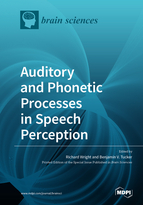Auditory and Phonetic Processes in Speech Perception
A special issue of Brain Sciences (ISSN 2076-3425). This special issue belongs to the section "Neurolinguistics".
Deadline for manuscript submissions: closed (20 February 2022) | Viewed by 36704
Special Issue Editors
Interests: phonetics; speech perception; psycholinguistics; auditory processes; acoustics
Special Issue Information
Dear Colleagues,
The past two decades have seen great advances in phonetic, auditory, and psycholinguistic research on speech perception. As the fields have advanced, there has been increasing interdisciplinary collaboration across them, which has in turn revealed their interdependence. The aim of this Special Issue is to bring together top scholars in these three related areas to present research in a single volume with papers ranging from the neurophysiology of hearing, to phonetic and linguistic factors, to factors related to hearing loss and assistive devices, second language learning and accentedness, and the processing of speech and the mental lexicon. We seek cutting-edge primary research on topics related to speech perception, including prosody, reduced linguistic variants, regional accents, language development, second language learning, neurophysiology and brain function, sociolinguistics, hearing loss, hearing aids and cochlear implants, listening context, unit predictability, lexical factors, and perceptual modeling.
Prof. Dr. Richard Wright
Guest Editor
Prof. Dr. Benjamin V. Tucker
Co-Guest Editor
Manuscript Submission Information
Manuscripts should be submitted online at www.mdpi.com by registering and logging in to this website. Once you are registered, click here to go to the submission form. Manuscripts can be submitted until the deadline. All submissions that pass pre-check are peer-reviewed. Accepted papers will be published continuously in the journal (as soon as accepted) and will be listed together on the special issue website. Research articles, review articles as well as short communications are invited. For planned papers, a title and short abstract (about 100 words) can be sent to the Editorial Office for announcement on this website.
Submitted manuscripts should not have been published previously, nor be under consideration for publication elsewhere (except conference proceedings papers). All manuscripts are thoroughly refereed through a single-blind peer-review process. A guide for authors and other relevant information for submission of manuscripts is available on the Instructions for Authors page. Brain Sciences is an international peer-reviewed open access monthly journal published by MDPI.
Please visit the Instructions for Authors page before submitting a manuscript. The Article Processing Charge (APC) for publication in this open access journal is 2200 CHF (Swiss Francs). Submitted papers should be well formatted and use good English. Authors may use MDPI's English editing service prior to publication or during author revisions.
Keywords
- phonetics
- speech perception
- auditory processing
- psycholinguistics
- hearing







